A Comprehensive Report on Robotic Process Automation in Accounting
VerifiedAdded on 2023/06/15
|20
|5391
|119
Report
AI Summary
This report provides a comprehensive analysis of Robotic Process Automation (RPA) in accounting functions, examining its potential impact and viability. It explores the pros and cons of this emerging technology, which is expected to replace human effort in various accounting processes. The report addresses key research questions regarding costs, agility, organizational acceptance, security, and societal impact. It also discusses the limitations of RPA, such as optical character recognition and fraud detection. The literature review incorporates case studies and research to support the analysis, ultimately assessing whether robo-accountants can fully replace human accountants or if human intervention remains crucial. Desklib offers a wealth of similar documents and study resources for students.

Paraphrase This Document
Need a fresh take? Get an instant paraphrase of this document with our AI Paraphraser

1
By student name
Professor
University
Date: 07November 2017.
1 | P a g e
By student name
Professor
University
Date: 07November 2017.
1 | P a g e
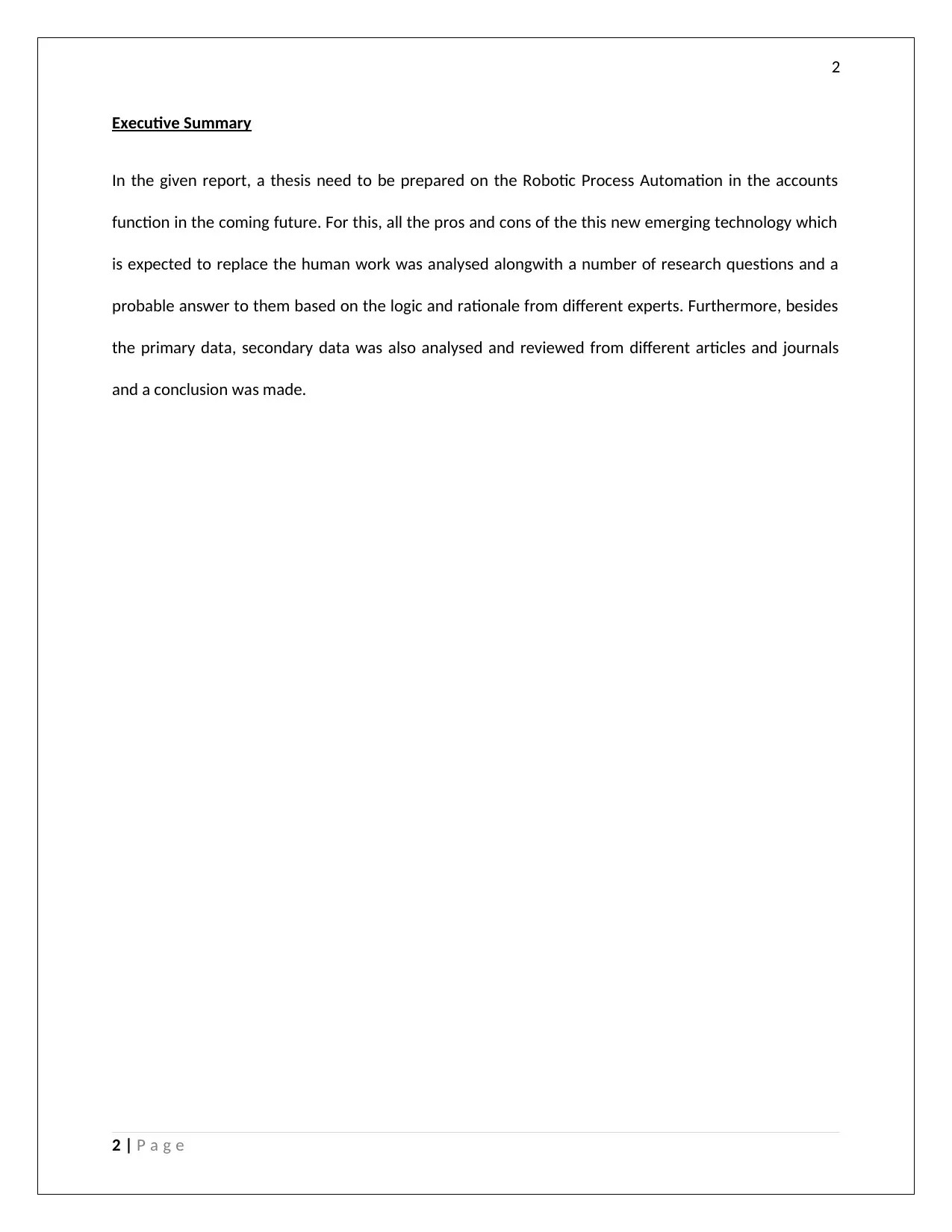
2
Executive Summary
In the given report, a thesis need to be prepared on the Robotic Process Automation in the accounts
function in the coming future. For this, all the pros and cons of the this new emerging technology which
is expected to replace the human work was analysed alongwith a number of research questions and a
probable answer to them based on the logic and rationale from different experts. Furthermore, besides
the primary data, secondary data was also analysed and reviewed from different articles and journals
and a conclusion was made.
2 | P a g e
Executive Summary
In the given report, a thesis need to be prepared on the Robotic Process Automation in the accounts
function in the coming future. For this, all the pros and cons of the this new emerging technology which
is expected to replace the human work was analysed alongwith a number of research questions and a
probable answer to them based on the logic and rationale from different experts. Furthermore, besides
the primary data, secondary data was also analysed and reviewed from different articles and journals
and a conclusion was made.
2 | P a g e
⊘ This is a preview!⊘
Do you want full access?
Subscribe today to unlock all pages.

Trusted by 1+ million students worldwide

3
Contents
Executive Summary..………………………….………....……..………………………………………..2
Introduction - Rationale for Study.……….…………..…………..………………………………..4
Reseach Objectives and research questions......……..……………………………………….5
Literature Review.……………………………….………....……..……………………………………….9
Research Methods……………………………….………....……..…………………………………….14
Conclusion….……………………………………….………....……..………………………………….….16
References.…..…………………………………….………....……..………………………………….….18
3 | P a g e
Contents
Executive Summary..………………………….………....……..………………………………………..2
Introduction - Rationale for Study.……….…………..…………..………………………………..4
Reseach Objectives and research questions......……..……………………………………….5
Literature Review.……………………………….………....……..……………………………………….9
Research Methods……………………………….………....……..…………………………………….14
Conclusion….……………………………………….………....……..………………………………….….16
References.…..…………………………………….………....……..………………………………….….18
3 | P a g e
Paraphrase This Document
Need a fresh take? Get an instant paraphrase of this document with our AI Paraphraser

4
Introduction – Rationale to Study
The robotic process automation has taken a wave and is emerging as one of the fastest growing
technologies in the digital arena. It is expected to replace the human effort in the accounting process
and and is one of the types of technology on clerical process automation based on the concept of
software based robotic systems and artificial intelligence. But, every new technology has both the
positive and the negative attributes much like every coin has 2 sides (Visinescu, Jones, & Sidorova,
2017). Though the robots will be process driven and will increase the level of accuracy, the speed, the
efficiency and will surely improve the level of compliance of the accounting process but the question is
will it be able to mitigate all the risks and challenges which we often see in the day to day accounting
operations. Even though articficial intelligence has developed a great deal in the last couple of years, but
it can never replace the human because of the lack of emotions, empathy and the lack of motivation and
intuition while making the business decisions. There are many such questions which needs to be
answered which forms the base of this thesis (Washington, DC: U.S. Patent and Trademark Office. Patent
No. U.S. Patent No. 9,555,544., 2017).
Furthermore, the objective and the rational of this study is to fid the rationality of the introduction of
robotics automation process in accounting system and how far is it sustainable in the modern
accounting theory which asks for decision making in complex real life situations which need to
investigate from various aspects and then to conclude based on the business and IFRS requirements. It
can be said that this process is a replica of the human behaviour which is interacting with the user
interface of the computer. In case, this is introduced, it will be a significant shift from the traditional
forms of IT integration (Visinescu, Jones, & Sidorova, 2017). This has been existing for a long period of
time now in the form of screen scraping but the same has now emerged into more resilient, mature,
reliance and scalable level which makes the large enterprise to believe and rely on it.
4 | P a g e
Introduction – Rationale to Study
The robotic process automation has taken a wave and is emerging as one of the fastest growing
technologies in the digital arena. It is expected to replace the human effort in the accounting process
and and is one of the types of technology on clerical process automation based on the concept of
software based robotic systems and artificial intelligence. But, every new technology has both the
positive and the negative attributes much like every coin has 2 sides (Visinescu, Jones, & Sidorova,
2017). Though the robots will be process driven and will increase the level of accuracy, the speed, the
efficiency and will surely improve the level of compliance of the accounting process but the question is
will it be able to mitigate all the risks and challenges which we often see in the day to day accounting
operations. Even though articficial intelligence has developed a great deal in the last couple of years, but
it can never replace the human because of the lack of emotions, empathy and the lack of motivation and
intuition while making the business decisions. There are many such questions which needs to be
answered which forms the base of this thesis (Washington, DC: U.S. Patent and Trademark Office. Patent
No. U.S. Patent No. 9,555,544., 2017).
Furthermore, the objective and the rational of this study is to fid the rationality of the introduction of
robotics automation process in accounting system and how far is it sustainable in the modern
accounting theory which asks for decision making in complex real life situations which need to
investigate from various aspects and then to conclude based on the business and IFRS requirements. It
can be said that this process is a replica of the human behaviour which is interacting with the user
interface of the computer. In case, this is introduced, it will be a significant shift from the traditional
forms of IT integration (Visinescu, Jones, & Sidorova, 2017). This has been existing for a long period of
time now in the form of screen scraping but the same has now emerged into more resilient, mature,
reliance and scalable level which makes the large enterprise to believe and rely on it.
4 | P a g e
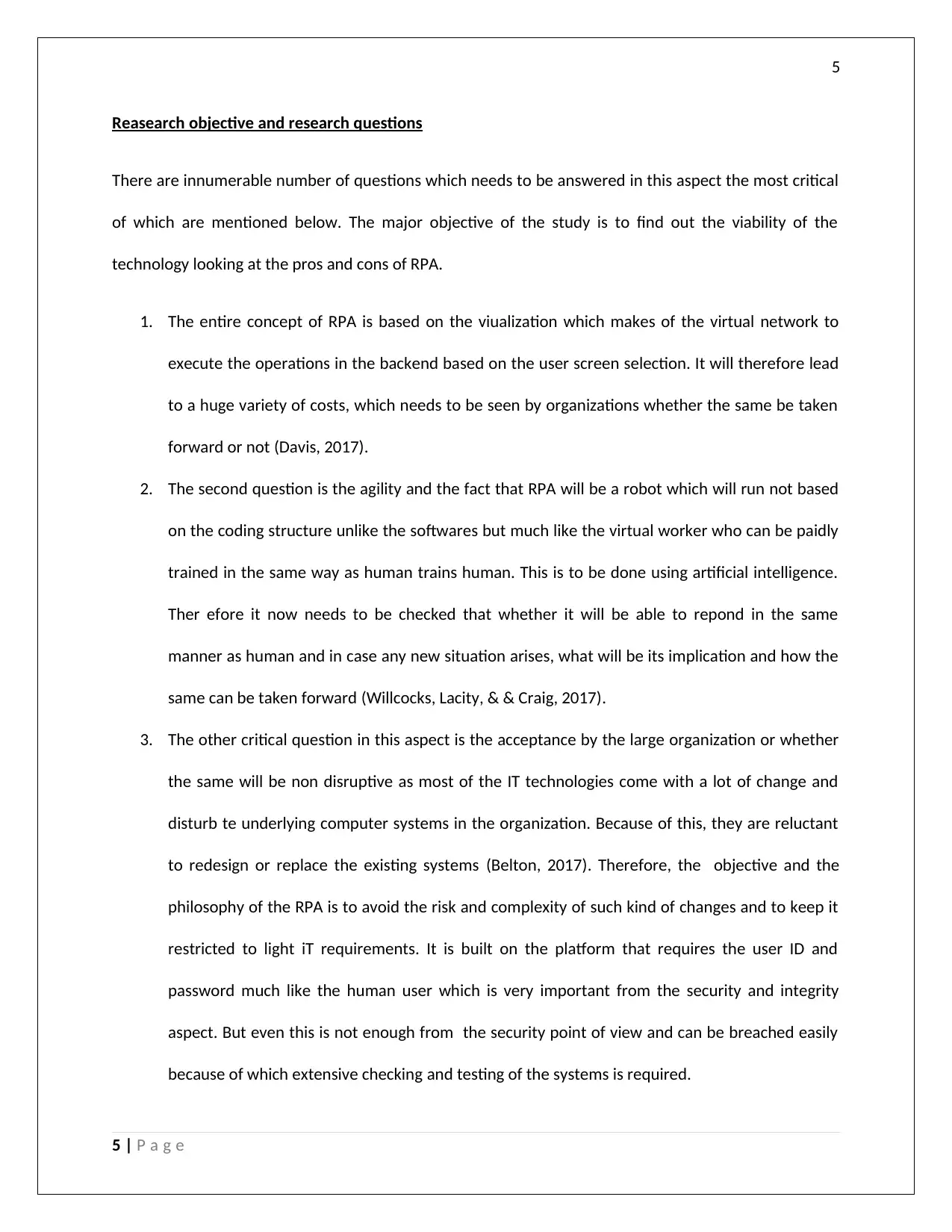
5
Reasearch objective and research questions
There are innumerable number of questions which needs to be answered in this aspect the most critical
of which are mentioned below. The major objective of the study is to find out the viability of the
technology looking at the pros and cons of RPA.
1. The entire concept of RPA is based on the viualization which makes of the virtual network to
execute the operations in the backend based on the user screen selection. It will therefore lead
to a huge variety of costs, which needs to be seen by organizations whether the same be taken
forward or not (Davis, 2017).
2. The second question is the agility and the fact that RPA will be a robot which will run not based
on the coding structure unlike the softwares but much like the virtual worker who can be paidly
trained in the same way as human trains human. This is to be done using artificial intelligence.
Ther efore it now needs to be checked that whether it will be able to repond in the same
manner as human and in case any new situation arises, what will be its implication and how the
same can be taken forward (Willcocks, Lacity, & & Craig, 2017).
3. The other critical question in this aspect is the acceptance by the large organization or whether
the same will be non disruptive as most of the IT technologies come with a lot of change and
disturb te underlying computer systems in the organization. Because of this, they are reluctant
to redesign or replace the existing systems (Belton, 2017). Therefore, the objective and the
philosophy of the RPA is to avoid the risk and complexity of such kind of changes and to keep it
restricted to light iT requirements. It is built on the platform that requires the user ID and
password much like the human user which is very important from the security and integrity
aspect. But even this is not enough from the security point of view and can be breached easily
because of which extensive checking and testing of the systems is required.
5 | P a g e
Reasearch objective and research questions
There are innumerable number of questions which needs to be answered in this aspect the most critical
of which are mentioned below. The major objective of the study is to find out the viability of the
technology looking at the pros and cons of RPA.
1. The entire concept of RPA is based on the viualization which makes of the virtual network to
execute the operations in the backend based on the user screen selection. It will therefore lead
to a huge variety of costs, which needs to be seen by organizations whether the same be taken
forward or not (Davis, 2017).
2. The second question is the agility and the fact that RPA will be a robot which will run not based
on the coding structure unlike the softwares but much like the virtual worker who can be paidly
trained in the same way as human trains human. This is to be done using artificial intelligence.
Ther efore it now needs to be checked that whether it will be able to repond in the same
manner as human and in case any new situation arises, what will be its implication and how the
same can be taken forward (Willcocks, Lacity, & & Craig, 2017).
3. The other critical question in this aspect is the acceptance by the large organization or whether
the same will be non disruptive as most of the IT technologies come with a lot of change and
disturb te underlying computer systems in the organization. Because of this, they are reluctant
to redesign or replace the existing systems (Belton, 2017). Therefore, the objective and the
philosophy of the RPA is to avoid the risk and complexity of such kind of changes and to keep it
restricted to light iT requirements. It is built on the platform that requires the user ID and
password much like the human user which is very important from the security and integrity
aspect. But even this is not enough from the security point of view and can be breached easily
because of which extensive checking and testing of the systems is required.
5 | P a g e
⊘ This is a preview!⊘
Do you want full access?
Subscribe today to unlock all pages.

Trusted by 1+ million students worldwide
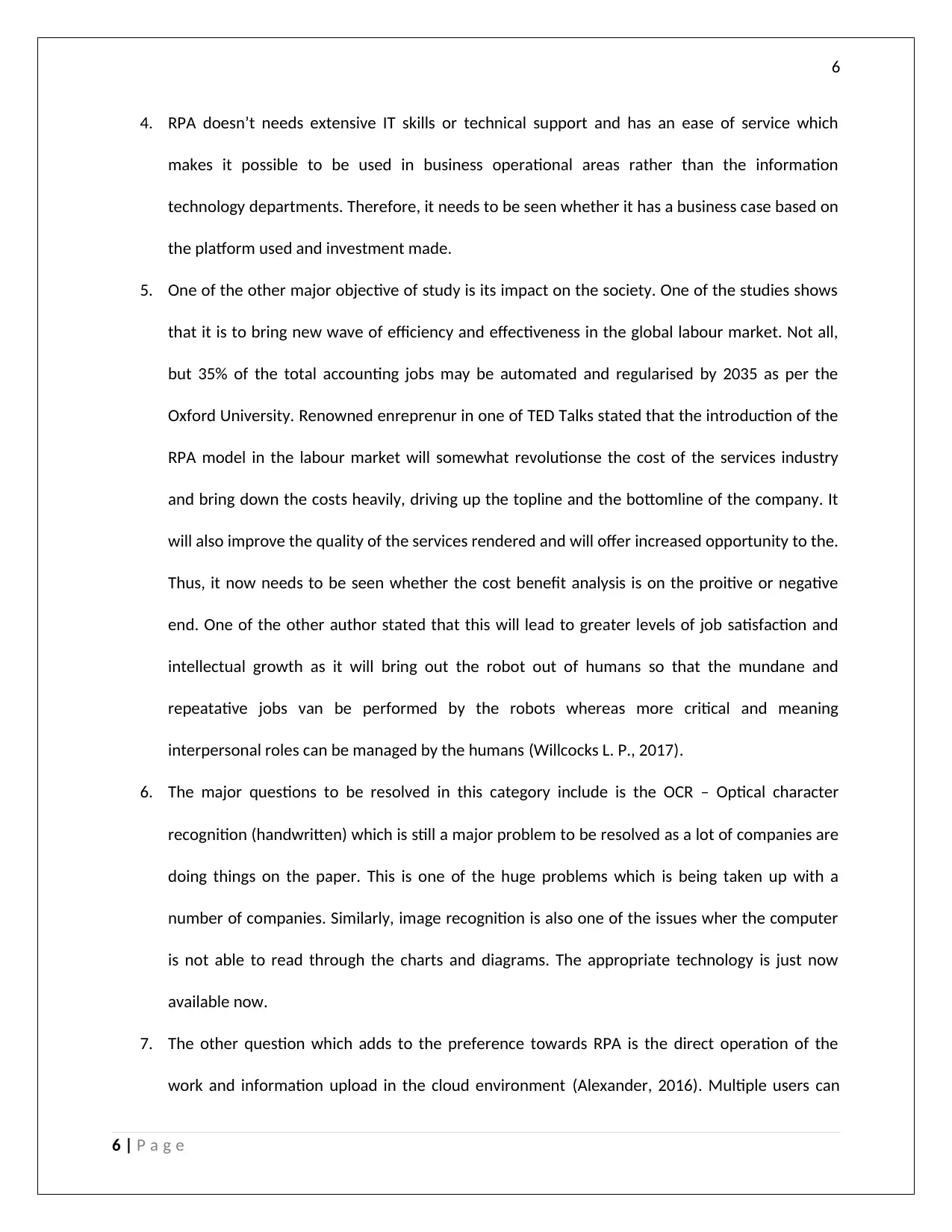
6
4. RPA doesn’t needs extensive IT skills or technical support and has an ease of service which
makes it possible to be used in business operational areas rather than the information
technology departments. Therefore, it needs to be seen whether it has a business case based on
the platform used and investment made.
5. One of the other major objective of study is its impact on the society. One of the studies shows
that it is to bring new wave of efficiency and effectiveness in the global labour market. Not all,
but 35% of the total accounting jobs may be automated and regularised by 2035 as per the
Oxford University. Renowned enreprenur in one of TED Talks stated that the introduction of the
RPA model in the labour market will somewhat revolutionse the cost of the services industry
and bring down the costs heavily, driving up the topline and the bottomline of the company. It
will also improve the quality of the services rendered and will offer increased opportunity to the.
Thus, it now needs to be seen whether the cost benefit analysis is on the proitive or negative
end. One of the other author stated that this will lead to greater levels of job satisfaction and
intellectual growth as it will bring out the robot out of humans so that the mundane and
repeatative jobs van be performed by the robots whereas more critical and meaning
interpersonal roles can be managed by the humans (Willcocks L. P., 2017).
6. The major questions to be resolved in this category include is the OCR – Optical character
recognition (handwritten) which is still a major problem to be resolved as a lot of companies are
doing things on the paper. This is one of the huge problems which is being taken up with a
number of companies. Similarly, image recognition is also one of the issues wher the computer
is not able to read through the charts and diagrams. The appropriate technology is just now
available now.
7. The other question which adds to the preference towards RPA is the direct operation of the
work and information upload in the cloud environment (Alexander, 2016). Multiple users can
6 | P a g e
4. RPA doesn’t needs extensive IT skills or technical support and has an ease of service which
makes it possible to be used in business operational areas rather than the information
technology departments. Therefore, it needs to be seen whether it has a business case based on
the platform used and investment made.
5. One of the other major objective of study is its impact on the society. One of the studies shows
that it is to bring new wave of efficiency and effectiveness in the global labour market. Not all,
but 35% of the total accounting jobs may be automated and regularised by 2035 as per the
Oxford University. Renowned enreprenur in one of TED Talks stated that the introduction of the
RPA model in the labour market will somewhat revolutionse the cost of the services industry
and bring down the costs heavily, driving up the topline and the bottomline of the company. It
will also improve the quality of the services rendered and will offer increased opportunity to the.
Thus, it now needs to be seen whether the cost benefit analysis is on the proitive or negative
end. One of the other author stated that this will lead to greater levels of job satisfaction and
intellectual growth as it will bring out the robot out of humans so that the mundane and
repeatative jobs van be performed by the robots whereas more critical and meaning
interpersonal roles can be managed by the humans (Willcocks L. P., 2017).
6. The major questions to be resolved in this category include is the OCR – Optical character
recognition (handwritten) which is still a major problem to be resolved as a lot of companies are
doing things on the paper. This is one of the huge problems which is being taken up with a
number of companies. Similarly, image recognition is also one of the issues wher the computer
is not able to read through the charts and diagrams. The appropriate technology is just now
available now.
7. The other question which adds to the preference towards RPA is the direct operation of the
work and information upload in the cloud environment (Alexander, 2016). Multiple users can
6 | P a g e
Paraphrase This Document
Need a fresh take? Get an instant paraphrase of this document with our AI Paraphraser

7
operate at a time from different destinations working on the same data using a single secure
device. But the question here is how safe the conncetion is and how can be it relied that the
data will not be lost and will not be overwritten or there will be a trail of the work in the system
in the automated version.
8. The other most important question here now is that can the robotics process automation
minimise the risks and help in detecting and avoiding the frauds. The question is open as both
the positive and negative aspects can be derived out of it. It very much minimises the risk by
removing the inefficiencies, the human error element being a software tool and artificial
intelligence driven tool. But, the risk equally increase in case the fraud has been commiteed
before the transaction or accounting entry gets into the system. It is very difficult and nearly
impossible for RPA to apply logics and rationale to identify the frauds and errors in the accounts
and to correct the same. Hence, it results in further wrong accounting and complete mismatch
and thereby increasing the risk (Kokina & Davenport, 2017). Therefore, the to avoid the same, it
is a must that the human needs to review and have a final check to ensure that the frauds are
detected at the right time and thus corrected immediately as RPA will be having a check only on
the arithematical accuracy and the logical checks as fed in the system.
9. The final question here is will robo accountants be able to replace the actual accountants or will
thye ever be able to set up and take the same competency levels as that of the human beings.
The answer to this question is a straight no as there will always be a gap in terms of the decision
making and IQ issue (Pape, 2017). The grit, the risk, the agility with which a human can make the
decision and help the business depending on the case and based on the time period required,
the current set of RPA does not has the expertise to attain it. The RPA is just meant for some
routine jobs which are process driven and away from fluctuations, whereas with humans, the
change is permanent and there can be immense number of scenarios that can be developed. In
7 | P a g e
operate at a time from different destinations working on the same data using a single secure
device. But the question here is how safe the conncetion is and how can be it relied that the
data will not be lost and will not be overwritten or there will be a trail of the work in the system
in the automated version.
8. The other most important question here now is that can the robotics process automation
minimise the risks and help in detecting and avoiding the frauds. The question is open as both
the positive and negative aspects can be derived out of it. It very much minimises the risk by
removing the inefficiencies, the human error element being a software tool and artificial
intelligence driven tool. But, the risk equally increase in case the fraud has been commiteed
before the transaction or accounting entry gets into the system. It is very difficult and nearly
impossible for RPA to apply logics and rationale to identify the frauds and errors in the accounts
and to correct the same. Hence, it results in further wrong accounting and complete mismatch
and thereby increasing the risk (Kokina & Davenport, 2017). Therefore, the to avoid the same, it
is a must that the human needs to review and have a final check to ensure that the frauds are
detected at the right time and thus corrected immediately as RPA will be having a check only on
the arithematical accuracy and the logical checks as fed in the system.
9. The final question here is will robo accountants be able to replace the actual accountants or will
thye ever be able to set up and take the same competency levels as that of the human beings.
The answer to this question is a straight no as there will always be a gap in terms of the decision
making and IQ issue (Pape, 2017). The grit, the risk, the agility with which a human can make the
decision and help the business depending on the case and based on the time period required,
the current set of RPA does not has the expertise to attain it. The RPA is just meant for some
routine jobs which are process driven and away from fluctuations, whereas with humans, the
change is permanent and there can be immense number of scenarios that can be developed. In
7 | P a g e
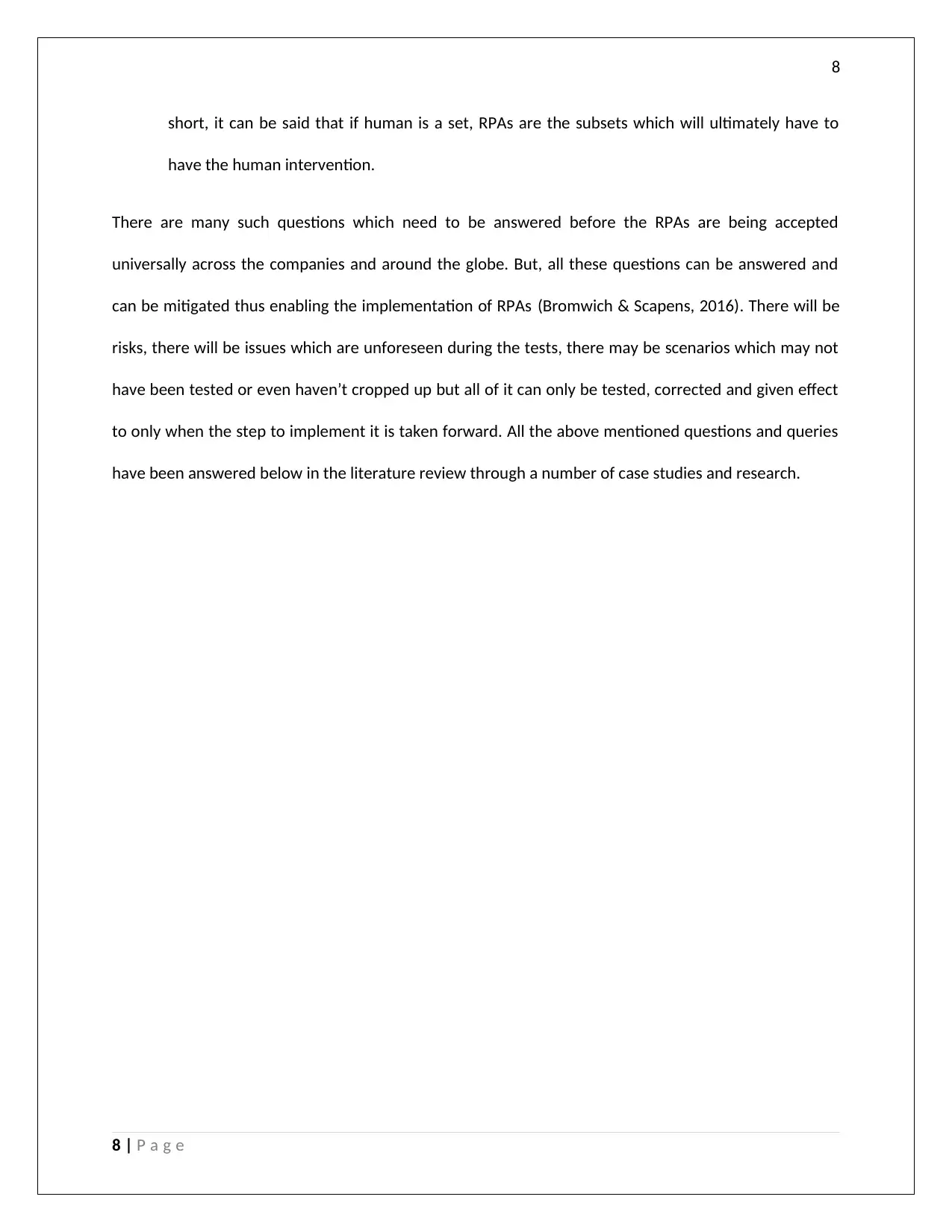
8
short, it can be said that if human is a set, RPAs are the subsets which will ultimately have to
have the human intervention.
There are many such questions which need to be answered before the RPAs are being accepted
universally across the companies and around the globe. But, all these questions can be answered and
can be mitigated thus enabling the implementation of RPAs (Bromwich & Scapens, 2016). There will be
risks, there will be issues which are unforeseen during the tests, there may be scenarios which may not
have been tested or even haven’t cropped up but all of it can only be tested, corrected and given effect
to only when the step to implement it is taken forward. All the above mentioned questions and queries
have been answered below in the literature review through a number of case studies and research.
8 | P a g e
short, it can be said that if human is a set, RPAs are the subsets which will ultimately have to
have the human intervention.
There are many such questions which need to be answered before the RPAs are being accepted
universally across the companies and around the globe. But, all these questions can be answered and
can be mitigated thus enabling the implementation of RPAs (Bromwich & Scapens, 2016). There will be
risks, there will be issues which are unforeseen during the tests, there may be scenarios which may not
have been tested or even haven’t cropped up but all of it can only be tested, corrected and given effect
to only when the step to implement it is taken forward. All the above mentioned questions and queries
have been answered below in the literature review through a number of case studies and research.
8 | P a g e
⊘ This is a preview!⊘
Do you want full access?
Subscribe today to unlock all pages.

Trusted by 1+ million students worldwide
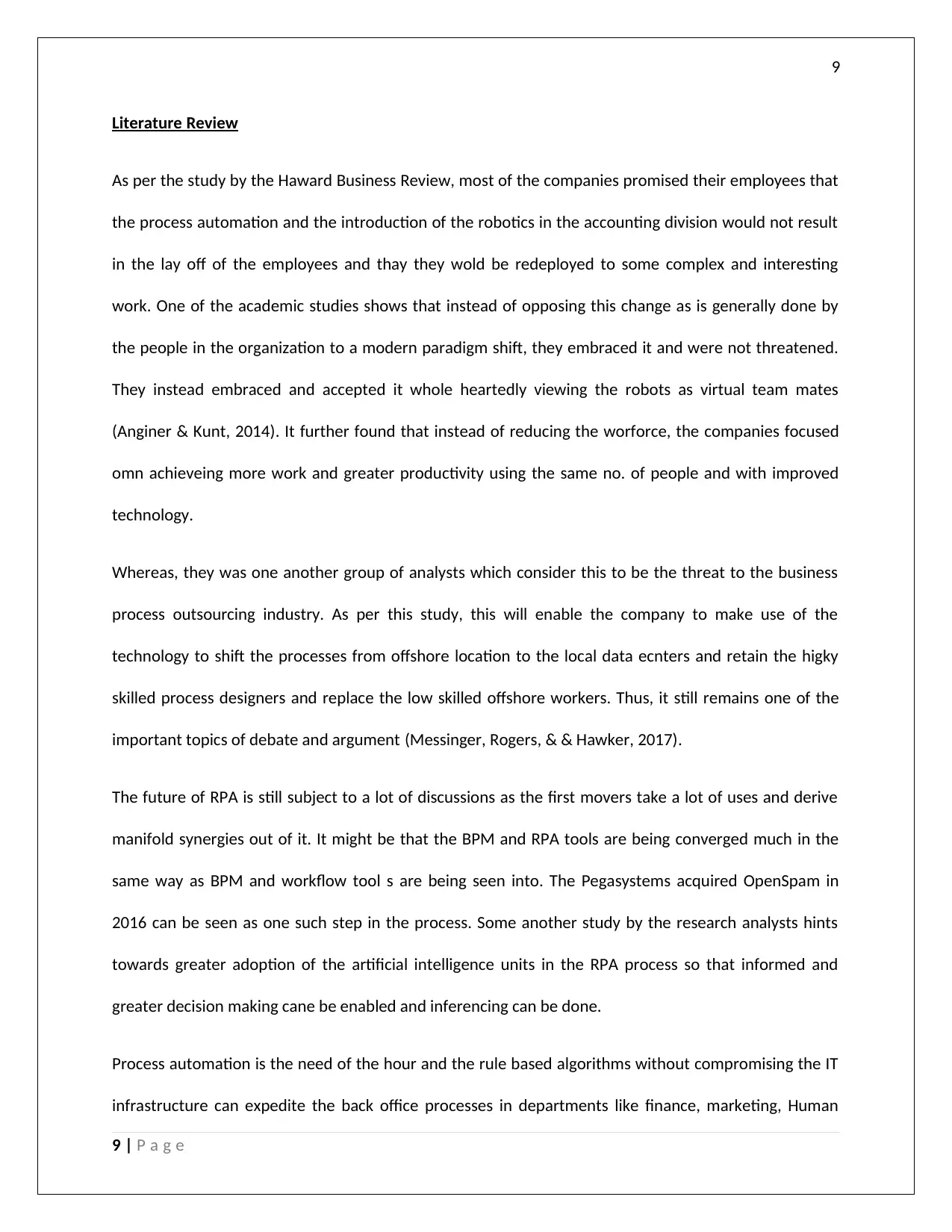
9
Literature Review
As per the study by the Haward Business Review, most of the companies promised their employees that
the process automation and the introduction of the robotics in the accounting division would not result
in the lay off of the employees and thay they wold be redeployed to some complex and interesting
work. One of the academic studies shows that instead of opposing this change as is generally done by
the people in the organization to a modern paradigm shift, they embraced it and were not threatened.
They instead embraced and accepted it whole heartedly viewing the robots as virtual team mates
(Anginer & Kunt, 2014). It further found that instead of reducing the worforce, the companies focused
omn achieveing more work and greater productivity using the same no. of people and with improved
technology.
Whereas, they was one another group of analysts which consider this to be the threat to the business
process outsourcing industry. As per this study, this will enable the company to make use of the
technology to shift the processes from offshore location to the local data ecnters and retain the higky
skilled process designers and replace the low skilled offshore workers. Thus, it still remains one of the
important topics of debate and argument (Messinger, Rogers, & & Hawker, 2017).
The future of RPA is still subject to a lot of discussions as the first movers take a lot of uses and derive
manifold synergies out of it. It might be that the BPM and RPA tools are being converged much in the
same way as BPM and workflow tool s are being seen into. The Pegasystems acquired OpenSpam in
2016 can be seen as one such step in the process. Some another study by the research analysts hints
towards greater adoption of the artificial intelligence units in the RPA process so that informed and
greater decision making cane be enabled and inferencing can be done.
Process automation is the need of the hour and the rule based algorithms without compromising the IT
infrastructure can expedite the back office processes in departments like finance, marketing, Human
9 | P a g e
Literature Review
As per the study by the Haward Business Review, most of the companies promised their employees that
the process automation and the introduction of the robotics in the accounting division would not result
in the lay off of the employees and thay they wold be redeployed to some complex and interesting
work. One of the academic studies shows that instead of opposing this change as is generally done by
the people in the organization to a modern paradigm shift, they embraced it and were not threatened.
They instead embraced and accepted it whole heartedly viewing the robots as virtual team mates
(Anginer & Kunt, 2014). It further found that instead of reducing the worforce, the companies focused
omn achieveing more work and greater productivity using the same no. of people and with improved
technology.
Whereas, they was one another group of analysts which consider this to be the threat to the business
process outsourcing industry. As per this study, this will enable the company to make use of the
technology to shift the processes from offshore location to the local data ecnters and retain the higky
skilled process designers and replace the low skilled offshore workers. Thus, it still remains one of the
important topics of debate and argument (Messinger, Rogers, & & Hawker, 2017).
The future of RPA is still subject to a lot of discussions as the first movers take a lot of uses and derive
manifold synergies out of it. It might be that the BPM and RPA tools are being converged much in the
same way as BPM and workflow tool s are being seen into. The Pegasystems acquired OpenSpam in
2016 can be seen as one such step in the process. Some another study by the research analysts hints
towards greater adoption of the artificial intelligence units in the RPA process so that informed and
greater decision making cane be enabled and inferencing can be done.
Process automation is the need of the hour and the rule based algorithms without compromising the IT
infrastructure can expedite the back office processes in departments like finance, marketing, Human
9 | P a g e
Paraphrase This Document
Need a fresh take? Get an instant paraphrase of this document with our AI Paraphraser
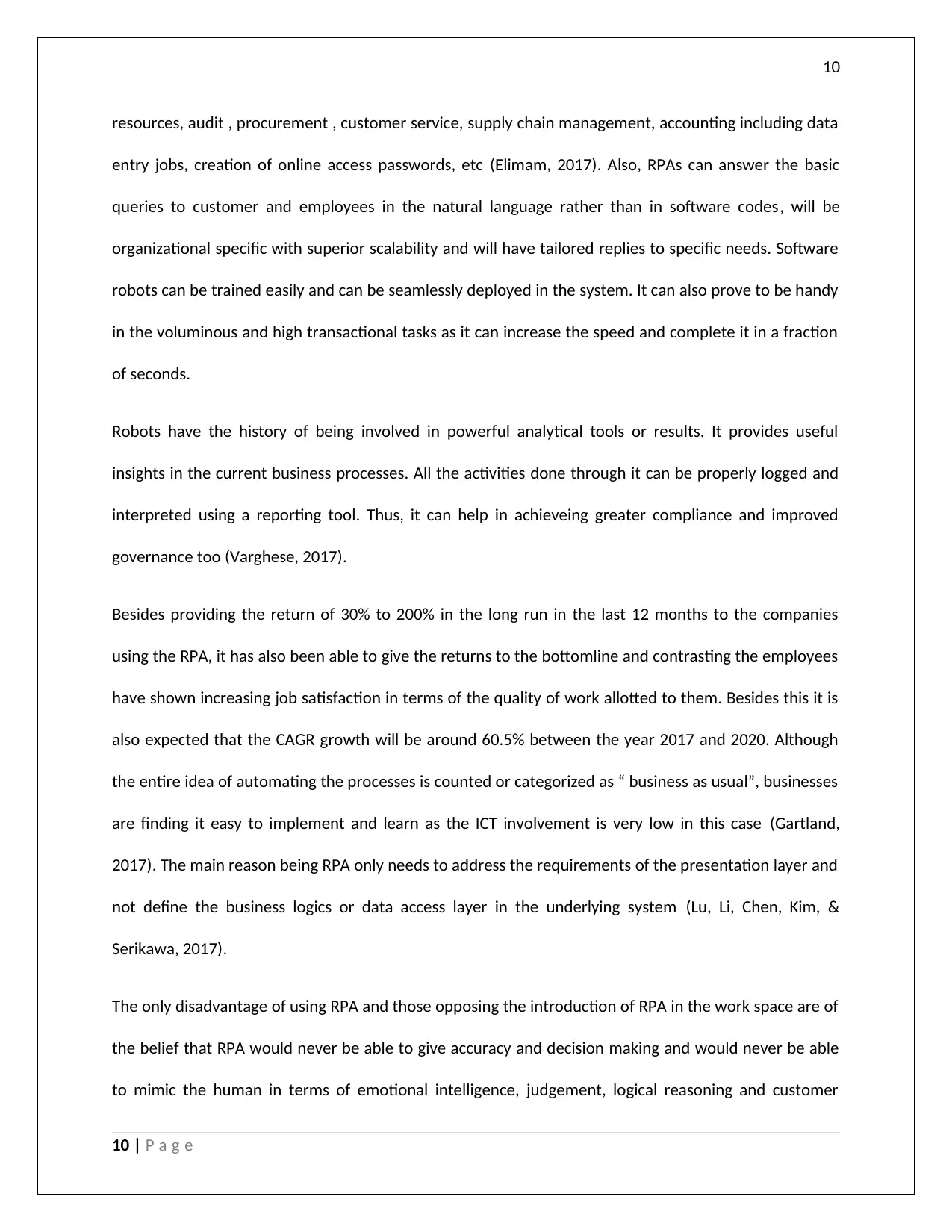
10
resources, audit , procurement , customer service, supply chain management, accounting including data
entry jobs, creation of online access passwords, etc (Elimam, 2017). Also, RPAs can answer the basic
queries to customer and employees in the natural language rather than in software codes, will be
organizational specific with superior scalability and will have tailored replies to specific needs. Software
robots can be trained easily and can be seamlessly deployed in the system. It can also prove to be handy
in the voluminous and high transactional tasks as it can increase the speed and complete it in a fraction
of seconds.
Robots have the history of being involved in powerful analytical tools or results. It provides useful
insights in the current business processes. All the activities done through it can be properly logged and
interpreted using a reporting tool. Thus, it can help in achieveing greater compliance and improved
governance too (Varghese, 2017).
Besides providing the return of 30% to 200% in the long run in the last 12 months to the companies
using the RPA, it has also been able to give the returns to the bottomline and contrasting the employees
have shown increasing job satisfaction in terms of the quality of work allotted to them. Besides this it is
also expected that the CAGR growth will be around 60.5% between the year 2017 and 2020. Although
the entire idea of automating the processes is counted or categorized as “ business as usual”, businesses
are finding it easy to implement and learn as the ICT involvement is very low in this case (Gartland,
2017). The main reason being RPA only needs to address the requirements of the presentation layer and
not define the business logics or data access layer in the underlying system (Lu, Li, Chen, Kim, &
Serikawa, 2017).
The only disadvantage of using RPA and those opposing the introduction of RPA in the work space are of
the belief that RPA would never be able to give accuracy and decision making and would never be able
to mimic the human in terms of emotional intelligence, judgement, logical reasoning and customer
10 | P a g e
resources, audit , procurement , customer service, supply chain management, accounting including data
entry jobs, creation of online access passwords, etc (Elimam, 2017). Also, RPAs can answer the basic
queries to customer and employees in the natural language rather than in software codes, will be
organizational specific with superior scalability and will have tailored replies to specific needs. Software
robots can be trained easily and can be seamlessly deployed in the system. It can also prove to be handy
in the voluminous and high transactional tasks as it can increase the speed and complete it in a fraction
of seconds.
Robots have the history of being involved in powerful analytical tools or results. It provides useful
insights in the current business processes. All the activities done through it can be properly logged and
interpreted using a reporting tool. Thus, it can help in achieveing greater compliance and improved
governance too (Varghese, 2017).
Besides providing the return of 30% to 200% in the long run in the last 12 months to the companies
using the RPA, it has also been able to give the returns to the bottomline and contrasting the employees
have shown increasing job satisfaction in terms of the quality of work allotted to them. Besides this it is
also expected that the CAGR growth will be around 60.5% between the year 2017 and 2020. Although
the entire idea of automating the processes is counted or categorized as “ business as usual”, businesses
are finding it easy to implement and learn as the ICT involvement is very low in this case (Gartland,
2017). The main reason being RPA only needs to address the requirements of the presentation layer and
not define the business logics or data access layer in the underlying system (Lu, Li, Chen, Kim, &
Serikawa, 2017).
The only disadvantage of using RPA and those opposing the introduction of RPA in the work space are of
the belief that RPA would never be able to give accuracy and decision making and would never be able
to mimic the human in terms of emotional intelligence, judgement, logical reasoning and customer
10 | P a g e
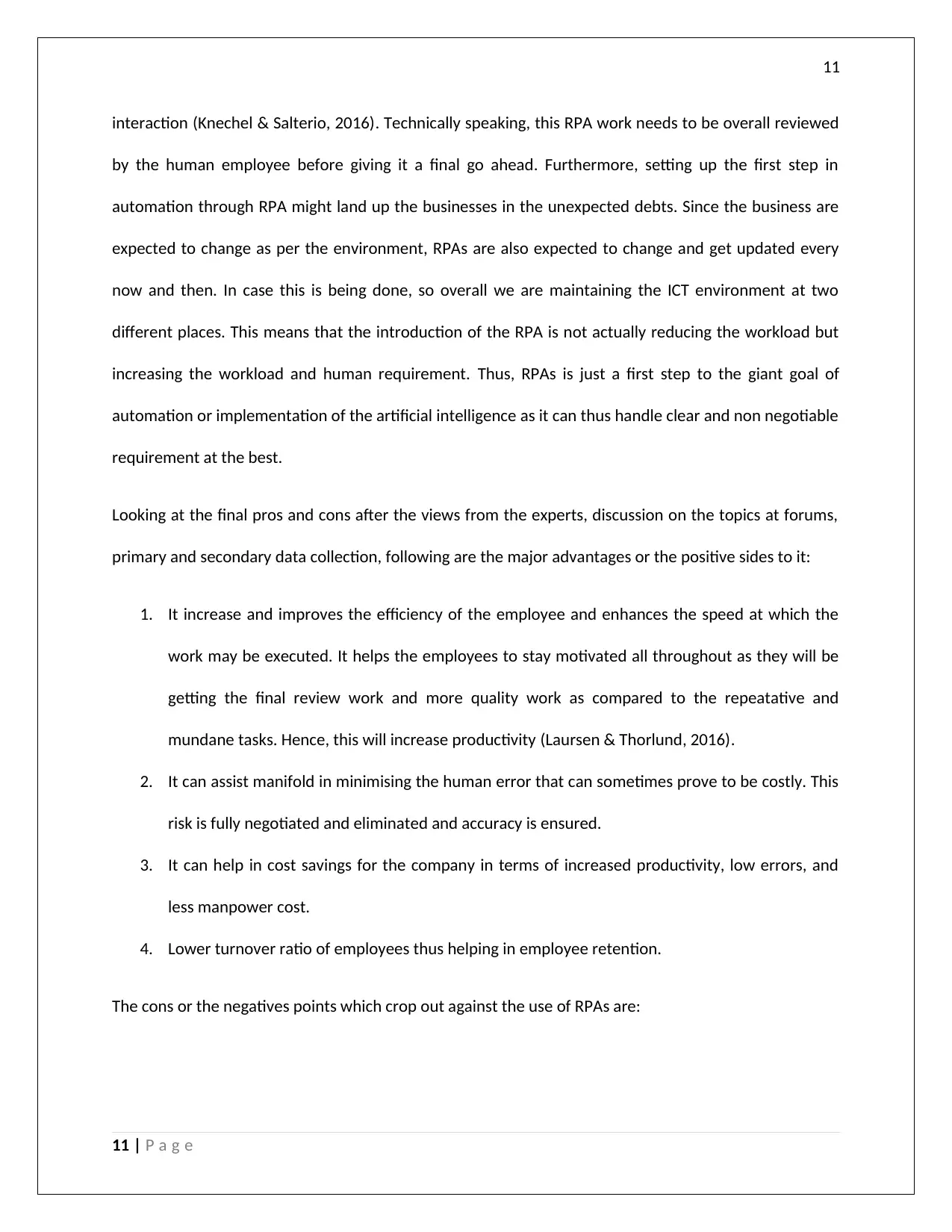
11
interaction (Knechel & Salterio, 2016). Technically speaking, this RPA work needs to be overall reviewed
by the human employee before giving it a final go ahead. Furthermore, setting up the first step in
automation through RPA might land up the businesses in the unexpected debts. Since the business are
expected to change as per the environment, RPAs are also expected to change and get updated every
now and then. In case this is being done, so overall we are maintaining the ICT environment at two
different places. This means that the introduction of the RPA is not actually reducing the workload but
increasing the workload and human requirement. Thus, RPAs is just a first step to the giant goal of
automation or implementation of the artificial intelligence as it can thus handle clear and non negotiable
requirement at the best.
Looking at the final pros and cons after the views from the experts, discussion on the topics at forums,
primary and secondary data collection, following are the major advantages or the positive sides to it:
1. It increase and improves the efficiency of the employee and enhances the speed at which the
work may be executed. It helps the employees to stay motivated all throughout as they will be
getting the final review work and more quality work as compared to the repeatative and
mundane tasks. Hence, this will increase productivity (Laursen & Thorlund, 2016).
2. It can assist manifold in minimising the human error that can sometimes prove to be costly. This
risk is fully negotiated and eliminated and accuracy is ensured.
3. It can help in cost savings for the company in terms of increased productivity, low errors, and
less manpower cost.
4. Lower turnover ratio of employees thus helping in employee retention.
The cons or the negatives points which crop out against the use of RPAs are:
11 | P a g e
interaction (Knechel & Salterio, 2016). Technically speaking, this RPA work needs to be overall reviewed
by the human employee before giving it a final go ahead. Furthermore, setting up the first step in
automation through RPA might land up the businesses in the unexpected debts. Since the business are
expected to change as per the environment, RPAs are also expected to change and get updated every
now and then. In case this is being done, so overall we are maintaining the ICT environment at two
different places. This means that the introduction of the RPA is not actually reducing the workload but
increasing the workload and human requirement. Thus, RPAs is just a first step to the giant goal of
automation or implementation of the artificial intelligence as it can thus handle clear and non negotiable
requirement at the best.
Looking at the final pros and cons after the views from the experts, discussion on the topics at forums,
primary and secondary data collection, following are the major advantages or the positive sides to it:
1. It increase and improves the efficiency of the employee and enhances the speed at which the
work may be executed. It helps the employees to stay motivated all throughout as they will be
getting the final review work and more quality work as compared to the repeatative and
mundane tasks. Hence, this will increase productivity (Laursen & Thorlund, 2016).
2. It can assist manifold in minimising the human error that can sometimes prove to be costly. This
risk is fully negotiated and eliminated and accuracy is ensured.
3. It can help in cost savings for the company in terms of increased productivity, low errors, and
less manpower cost.
4. Lower turnover ratio of employees thus helping in employee retention.
The cons or the negatives points which crop out against the use of RPAs are:
11 | P a g e
⊘ This is a preview!⊘
Do you want full access?
Subscribe today to unlock all pages.

Trusted by 1+ million students worldwide
1 out of 20
Related Documents
Your All-in-One AI-Powered Toolkit for Academic Success.
+13062052269
info@desklib.com
Available 24*7 on WhatsApp / Email
![[object Object]](/_next/static/media/star-bottom.7253800d.svg)
Unlock your academic potential
Copyright © 2020–2025 A2Z Services. All Rights Reserved. Developed and managed by ZUCOL.



